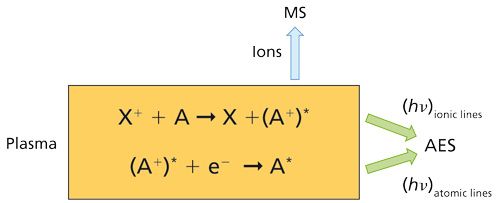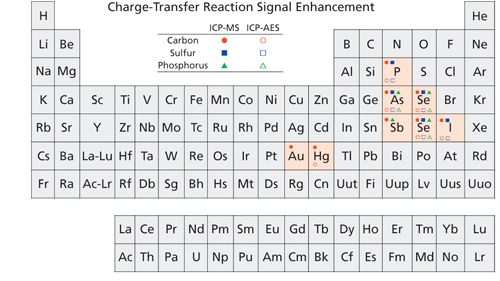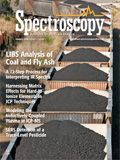How to Improve Analytical Figures of Merit of Hard-To-Ionize Elements in ICP-Based Techniques
Signal suppression caused by matrix effects has long presented challenges to analysts using inductively coupled plasma–atomic emission spectrometry (ICP-AES) and inductively coupled plasma–mass spectrometry (ICP-MS) techniques. In some cases, however, matrix effects enhance the signal, and thus benefit the analysis. Guillermo Grindlay of the University of Alicante, in Spain, has been studying signal enhancement by charge-transfer reactions resulting from the presence of carbon, sulfur, and phosphorus in the sample matrix. His aim is to better understand under what conditions these matrix effects occur and what mechanisms are involved, to assist analysts in managing interferences and improving the analytical figures of merit in their work. He recently spoke to us about his research.
Pages 48–51
Signal suppression caused by matrix effects has long presented challenges to analysts using inductively coupled plasma–atomic emission spectrometry (ICP-AES) and inductively coupled plasma–mass spectrometry (ICP-MS) techniques. In some cases, however, matrix effects enhance the signal, and thus benefit the analysis. Guillermo Grindlay of the University of Alicante, in Spain, has been studying signal enhancement by charge-transfer reactions resulting from the presence of carbon, sulfur, and phosphorus in the sample matrix. His aim is to better understand under what conditions these matrix effects occur and what mechanisms are involved, to assist analysts in managing interferences and improving the analytical figures of merit in their work. He recently spoke to us about his research.
What is a hard-to-ionize element? Why are these elements so difficult to analyze in ICP-based techniques?
Hard-to-ionize elements make reference to those species with ionization energies above 8–9 eV (for example, B, As, Se, and so on). The degree of ionization for these elements is very low in Ar-based plasmas under normal conditions, negatively affecting detection capabilities in ICP-MS. Moreover, atomic and ionic emission for these elements in ICP-AES are very weak in the UV-vis region.
What are the most common analytical approaches to improve analytical figures of merit for hard-to-ionize elements?
Analytical figures of merit for hard-to-ionize elements are usually improved by means of time-consuming sample pretreatments (such as preconcentration). Alternatively, high-efficiency sample introduction devices (such as micronebulizers, desolvation systems, and so forth) can be employed, but they are significantly more expensive and more difficult to manage than the conventional system (a pneumatic nebulizer plus a spray chamber).
It has been observed that the presence of some concomitants in the plasma can selectively increase the signal intensity of certain hard-to-ionize elements in ICP-MS (1). What do your studies indicate about the impact on hard-to-ionize elements resulting from the presence of carbon in the sample matrix?
As you have mentioned, several studies in the literature have shown that sensitivity improvements for hard-to-ionize elements in ICP-MS can be easily achieved by introducing carbon in the plasma. Signal enhancement has been partially attributed to changes on the analyte ionization pathway. However, this phenomenon has not been systematically studied. In our work, we have investigated this topic in detail. Results have shown that carbon matrix effects for hard-to-ionize elements in ICP-MS are rather complex. We have seen that As, Au, Hg, I, P, Se, Sb, and Te sensitivities are always higher for carbon-containing solutions when compared to nitric acid-containing ones. The remaining hard-to-ionize elements (B, Be, Cd, Ir, Pd, Pt, Os, S, and Zn) and easy-to-ionize elements may show matrix effects--either signal enhancement or signal suppression-depending on the experimental conditions selected. Matrix effects for both groups of analytes are partially related to changes in the spatial distribution of ions in the plasma resulting from the cooling effect because of the introduction of solution into the central channel of the plasma, which delays analyte atomization and ionization. However, signal enhancement for As, Au, Hg, I, P, Se, Sb, and Te is also related to changes in ion population within the plasma resulting from carbon-based charge-transfer reactions.
What does your study indicate about why the presence of carbon increases the signal intensity of some hard-to-ionize elements but not others?
As explained before, the main differences in matrix effects among hard-to-ionize elements are related to the occurrence of carbon-based charge-transfer reactions. This type of reaction is based on the transfer of charge between charged carbon-containing species (X+) such as C+ and analyte atoms (A), resulting in an excited analyte ion (A+)* (Figure 1). Charge transfer reactions are highly specific and involve atomic and high-energy ionic levels of the analyte. For appreciable charge transfer to occur, two requirements must be fulfilled. First, the reaction energy defect (ΔE) should be minimal. This means that analyte ions should have an electronic level close in energy to that of the charged carbon-containing species (C: 11.26 eV; CO: 14.00 eV; and so forth). Second, the total spin number of reactants and products should be conserved. Charge-transfer theoretical considerations support the signal enhancement observed for As, Au, Hg, I, P, Se, Sb, and Te in ICP-MS. Nonetheless, additional factors could be involved in this phenomenon. Other elements such as B, Be, Cd, Ir, Pt, Os, and S also fulfill reaction requirements with some charged carbon-containing species but no experimental signal enhancement is observed. Further studies are required to explain these findings.

Figure 1: Carbon-based charge-transfer reaction mechanism in ICP-based techniques.

Figure 2: Elements affected by carbon-, sulfur-, and phosphorus-based charge-transfer reactions in ICP-based techniques.
In this study, you also evaluated the influence of a number of plasma parameters, sample introduction systems, and carbon matrix types and concentrations. Under which experimental conditions was the greatest signal enhancement effect seen for those elements affected by carbon-based charge-transfer reaction?
The magnitude of signal enhancement depends on the amount of charged carbon-containing species in the plasma (Figure 1). Therefore, matrix effects are expected to be more significant when increasing the carbon load into the plasma as well as when improving plasma atomization or ionization conditions. In fact, it was observed that signal enhancement for As, Au, Hg, I, P, Se, Sb, and Te was more significant when operating with more-efficient sample introduction systems (such as cyclonic spray chambers), increasing carbon concentration in the sample, and operating with robust conditions (such as high plasma r.f. power and a low nebulizer gas flow rate). Arsenic and selenium shown the highest signal enhancement factors (>100%) whereas Sb was the element less affected by carbon-based charge-transfer reactions (<20%).
How did these results vary depending on mass spectrometer characteristics?
Signal enhancement resulting from carbon-based charge-transfer reactions was more intense for a double-focusing sector-field mass spectrometer than for a quadrupole filter one. The origin of this result is not clear, given the significant differences in the instrumentation design. In any case, the relative behavior among hard-to-ionize elements was similar for both instruments.
You then did a study to investigate the influence of carbon-based charge-transfer reactions on the analytical response of atomic and ionic emission lines of hard-to-ionize elements in axially viewed ICP-AES (3). Was the influence of carbon-based charge-transfer effects different in ICP-AES compared to ICP-MS?
Studying these effects in ICP-AES is by far more complex than in ICP-MS, since the influence of line characteristics (atomic or ionic) as well as all the mechanisms controlling the population of excited electronic states has to be taken into account. In general, for elements affected by charge-transfer reactions, the emission for atomic lines is enhanced by carbon. Experimental results suggest that once an analyte ion population is increased by the charge-transfer reaction, analyte ions (A+)* should suffer from subsequent electron recombination, overpopulating certain atomic levels (A*) (Figure 1). According to this mechanism, increased emission signals for ionic wavelengths would have also been expected. However, with the exception of Hg, emission signals for ionic lines were not high enough to draw any conclusion about this subject. Both Hg atomic and ionic lines were positively affected by charge-transfer reactions. As expected, elements showing signal enhancement in ICP-AES (such as As, Hg, I, P, Se, and Te) were similar to those reported in ICP-MS. However, contradictory findings were observed for Au and Sb behavior in ICP-based techniques. Ionization for these elements is enhanced in ICP-MS but negative matrix effects were registered in ICP-AES for both atomic and ionic lines. Finally, it is worth mentioning that the magnitude of matrix effects in ICP-AES was less significant than in ICP-MS. For example, signal enhancement for As and Se was always lower than 30%.
You have also found that the presence of sulfur and phosphorus in the plasma also led to selective signal enhancement for some hard-to-ionize elements in ICP-MS (2,3). Is the origin of this phenomenon also related to charge-transfer reactions?
When introducing sulfur and phosphorus as inorganic acids (H2SO4 and H3PO4) in ICP-MS, signal suppression is usually seen for hard-to-ionize elements when compared to nitric acid solutions because of a decrease in the amount of analyte reaching the plasma as well as in plasma energetic conditions. Nonetheless, we have found that the signal for some hard-to-ionize elements (As, I, P, Se, and Te) is enhanced in the presence of sulfur and phosphorus, similar to what happens in carbon-containing matrices. The origin of this phenomenon is also explained by means of charge-transfer reactions with sulfur- and phosphorus-containing species (S+ and P+) in the plasma.
Were there differences in the sulfur- and phosphorus-based charge-transfer effects in ICP-AES compared to ICP-MS?
Generally speaking, differences in matrix effects for sulfur- and phosphorus-based charge transfer in ICP-AES to ICP-MS were similar to those previously mentioned for carbon. Only signal enhancement for atomic lines was observed. However, some differences in matrix effects were noticed for some elements. For instance, none of the atomic or ionic lines of Sb show a positive matrix effect in ICP-AES, whereas ion signal for this element in ICP-MS is enhanced.
From a practical point of view, how does the analyst make use of concomitant-based charge transfer reactions to improve analytical figures of merit for hard-to-ionize elements in ICP-based techniques?
In general, a concomitant-containing compound can be employed during sample preparation (glycerol, methanol, sulfuric acid, and so on). Alternatively, carbon could also be introduced into the plasma as a gas (such as carbon dioxide or methane) with the aid of a T-joint in the torch base. The amount of the concomitant should be optimized by the analyst according to the matrix source employed as well as instrument characteristics. It should be high enough to maximize concomitant ion population in the plasma without compromising plasma robustness and long-term stability. Needless to say, this approach could be implemented together with other procedures (such as sample preparation or using alternative sample introduction devices) to achieve ultimate detection capabilities. Finally, it is important to keep in mind that when using internal standardization, both the internal standard and the analyte should behave similarly with regard to charge-transfer reactions (such as As or Te as internal standards for Se determination).
References
- G. Grindlay, J. Mora, M. de Loos-Vollebregt, and F. Vanhaecke, Spectrochim. Acta, Part B86, 42–49 (2013).
- M.C. García-Poyo, G. Grindlay, L. Gras, M.T.C. de Loos-Vollebregt, and J. Mora, Spectrochim. Acta, Part B105, 71–76 (2015).
- G. Grindlay, L. Gras, J. Mora, and M.T.C. de Loos-Vollebregt, Spectrochim. Acta, Part B115, 8–15 (2016).

High-Speed Laser MS for Precise, Prep-Free Environmental Particle Tracking
April 21st 2025Scientists at Oak Ridge National Laboratory have demonstrated that a fast, laser-based mass spectrometry method—LA-ICP-TOF-MS—can accurately detect and identify airborne environmental particles, including toxic metal particles like ruthenium, without the need for complex sample preparation. The work offers a breakthrough in rapid, high-resolution analysis of environmental pollutants.
Trending on Spectroscopy: The Top Content of 2024
December 30th 2024In 2024, we launched multiple content series, covered major conferences, presented two awards, and continued our monthly Analytically Speaking episodes. Below, you'll find a selection of the most popular content from Spectroscopy over the past year.